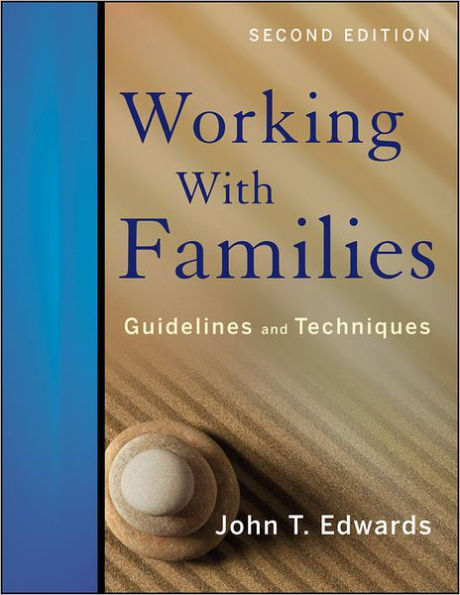Table of Contents
PREFACE xi
ACKNOWLEDGMENTS xiii
CHAPTER 1: FOUNDATION IDEAS 1
Introduction 2
Part 1: Concepts 3
Learning Family Counseling 3
Why Family Work? 4
Assumptions of a Family Systems Model 5
The Systems Orientation in Theory 6
The Systems Orientation in Practice 7
The Systems Orientation in Concepts 8
Levels of Systems Interventions 9
Cause and Effect in Systems 11
The Systems-Oriented Program Assessment 12
Code of Ethics 13
Cultural Sensitivity 14
Uses of Family Counseling 16
Forms of Family Work 17
Family Work in Different Settings 18
Suggestions for Family Work in Different Settings 20
Rationales for This Approach 22
Bedrock Beliefs About Families 23
A Theory of Change 24
Children Raise Adults 25
Neglected Relationships in Family Counseling 26
Getting a Grip on the Obvious 27
Experience Is Primary 28
Too Many Variables 29
Too-Brief Family Counseling 30
Traveling Pairs of Concepts 31
Research on Marital and Family Therapy 32
Part 2: Procedures and Processes 37
Recruiting Families for Counseling 37
Conducting the Initial Family Interview 40
Initial Interview Summary 42
Tips for the First Family Interview 43
Four Basic Tools for Family Counseling 44
General Guidelines 46
If the Presenting Problem Is a Child or Young Person 49
If the Presenting Problem Is a Marital or Couples Issue 51
General Clinical Suggestions 53
Session-by-Session Guidelines 56
Session Checklist for Family Counseling 57
CHAPTER 2: SPECIAL SITUATIONS 58
Introduction 59
Therapeutic Themes by Family Type (Child Identified Patient) 60
Blended and Single-Parent Families 62
Blended Families: Tips for Two Common Scenarios 64
The Powerless Parent 65
The Parental Mind-Set 66
Parent-Child Enmeshment 67
‘‘Split’’ Parenting 68
Parental Denial 69
Difficult Parents 70
Child Diagnosis in Plain English 71
The Three Worlds of the Adolescent 73
Managing Adolescents in Family Sessions 74
Couples Work 75
Couples Counseling: Additional Tips 77
Closed Families 78
Friends as Family 79
Family Resistance 80
CHAPTER 3: COUNSELOR IDEAS 83
Introduction 84
Fear of Family Work 85
Inexperienced vs. Experienced Family Counselors 86
A Novice’s First Family Interview 87
Counseling Style 89
Counselor Mistakes 92
Counselor Successes 93
Counselor Self-Disclosure 94
Induction Worksheet 95
Whose Family Stuff Is It? 96
Use of Self 97
Counselor Centrality 98
Colleague Consultation 99
Supervising Family Work 100
Review Lists for Family Counselors 101
Questions and Answers 105
CHAPTER 4: TECHNIQUES 106
Introduction 107
Alter Ego 108
Brief Network Intervention (BNI) 109
Chair Work 111
Circular Questions 112
Colleague Teamwork 113
Drawings 115
Family Mapping 117
Family Questions in Individual Counseling 119
Guardrail 120
The MIGS Sheet 121
New Talk 126
Paradox 127
Parent’s Childhood 128
Reflecting Team 129
Reframing 130
Relabeling 133
Safe Rebellion134
Sculpting and Movement 135
Sibling Talk 137
Strategic Child Assessment 138
Strategic Predictions 139
Toybox 140
Worried Child 141
Summary of Systemic Techniques 142
CHAPTER 5: MULTIPLE FAMILY GROUPS 143
Introduction 144
Suggested Procedures for Multiple Family Groups 145
Family Recruitment for Multiple Family Groups 145
Clinical Tips 146
Therapeutic Activities 147
CHAPTER 6: WORKING WITH CHEMICAL DEPENDENCY IN FAMILIES 149
Introduction 150
A Working Definition of Chemical Dependency 151
Drugs of Abuse 152
Chemical Dependency 153
The Disease Concept 154
Indirect Signs of Chemical Dependency 155
Identification of Chemical Dependency in a Family 156
Questions for Family Assessment of Chemical Dependency 156
Treatment of Chemical Dependency 157
Recovery 158
Stages of Recovery 159
Recovery Plan 160
Families in Early Recovery 161
Relapse 162
Common Patterns in Chemically Dependent Families 163
Two Parent—CD Parent 164
Two-Parent—CD Adolescent 165
‘‘Good’’ Kid/‘‘Bad’’ Kid 166
CD Single Parent 167
Single-Parent—CD Adolescent 168
The Golden Years Trap 169
Adolescent Substance Abuse 171
Adolescent Substance Use Checklist 172
Co-Dependency 173
Couples Work for Chemical Dependency 174
Working With Chemical Dependency in Families: 21 Guidelines 176
Family Counseling for Chemical Dependency: Summary 178
APPENDIX A: RESEARCH REFERENCES 179
APPENDIX B: PROBLEMS AND PAGE NUMBERS 182
GLOSSARY FOR FAMILY COUNSELING 183
RECOMMENDED READINGS 185
ABOUT THE AUTHOR 187
INDEX 189




